Bahia is a party all year long. Popular festivities follow, concentrated in the summer, but extending throughout the year, including the June festivals. Folklore manifestations, from different origins, proliferate with outdoor exhibitions of capoeira, maculelê and samba-de-roda. Thousands of people take to the streets to celebrate the patron saints. In addition to being popular, these festivals are characterized by religious syncretism and a mixture of sacred and profane elements.
The entire faith of Bahia is manifested in the cycle of popular festivals, from the celebrations of the Candomblé orixás, when all the terreiros in the city beat their drums for their saint-children to dance, to the Catholic religion’s festivities, which gain a stamp profane with a lot of samba-de-roda & standardized tents serving drinks & a variety of food.
This party atmosphere permeates the whole city, from morning to night, but in early December, the schedule intensifies. The cycle begins on December 4th, with the Festa de Santa Bárbara, and peaks at Lavagem do Bonfim, Festa de Iemanjá and Carnaval. Currently, the most traditional are: Bom Jesus dos Navegantes, Lavagem do Bonfim and Iemanjá.
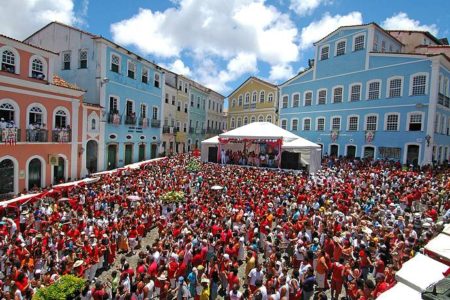
Festa de Santa Barbara
Santa Bárbara is one of the most worshiped deities in Bahia. Every December 4, thousands of Bahians attend lectures and make carurus at home to revere her; Around 1641, merchants and workers at the Santa Bárbara Market, in Comércio, decided to pay homage to the saint. Since then, celebrations have become a tradition. Every December 4th, thousands of Bahians attend lectures and make carurus at home to revere her.
Santa Barbara is one of the most revered deities in Bahia. She is the godmother of the Fire Department and patron of the markets. In Candomblé, she is represented by the deity Iansã – warrior saint, lady of lightning, wind and thunder.
Currently, the homage to the saint lasts three days and begins with a mass at the Church of Nossa Senhora do Rosário dos Pretos, in Pelourinho, where her image is exposed. Then, a procession travels through the streets of the Historic Center, passing in front of the Fire Department headquarters. During the closing of the religious festival, the traditional caruru is distributed, prepared by volunteers and served for free, always accompanied by a lot of samba de roda and capoeira.
When: December 4th
Where: Salvador
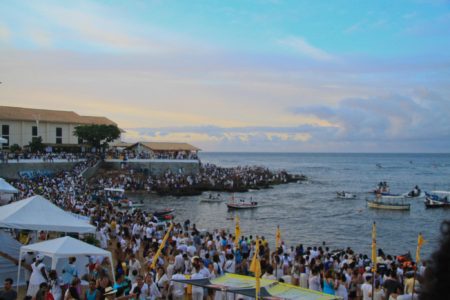
Festa de Lemanja
The Festival of Yemanjá is one of the most popular and valued of the year, attracting to the beaches of the Red River (Salvador, Bahia) a huge crowd of faithful and admirers. On the island of Itaparica because it is a little away from Salvador, it is made by the locals and appreciated by visitors to the island of Salvador.
When: February 2nd
Where: Salvador
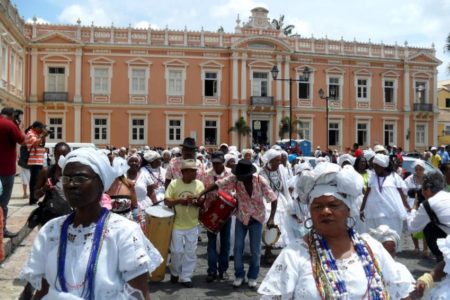
On December 2nd, the National Samba Day is celebrated. Established by the City Council of Salvador, in 1940, it was part of the homage to composer Ary Barroso, who a year earlier had released “Aquarela do Brasil”, the best known music, performed and recorded outside Brazil. Every year there is a commemorative show of Samba Day, in a public square, in Terreiro de Jesus, located in Pelourinho.
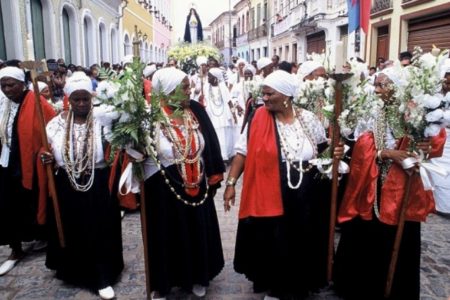
A Festa da Irmandade da Boa Morte (August 13th to 15th)
The historiography of these notable waterfall women continues to challenge the intelligence of young researchers. Their secret rituals linked to the cult of the orixás are also requiring ethnographic reading that respects, of course, the limits to the maintenance of secrets, so important in the maintenance of this religious aspect. What has been highlighted is the external aspect of the cult referred almost entirely to Catholic symbolism and its Afro-Brazilian appropriation.
During the beginning of August, a long public program attracts people from all over the waterfall, in what Moraes Ribeiro considers the most representative living document of Brazilian, Baroque, Ibero-African religiosity.
Suppers, processions, masses, processions, samba-de-roda place around 30 remnants of the Brotherhood, which already had more than 200, at the center of events in the provincial city and, lately, in the main news organizations of the capital and on TV news. The festival itself has a calendar that includes the confession of members in the Main Church, a procession representing the death of Our Lady, a sentry, followed by a white supper, consisting of bread, wine and seafood, obeying religious customs that prohibit the access to oil palm and meat on Friday, a day dedicated to Oxalá, creator of the Universe, and procession for the funeral of Nossa Senhora da Boa Morte, where the sisters wear formal dress.
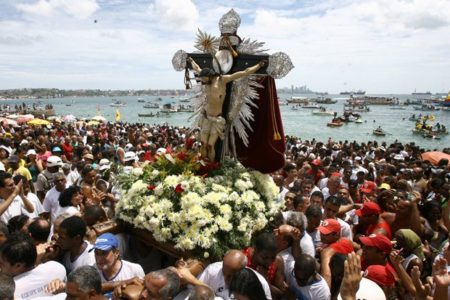
Procissão Bom Jesus dos Navegantes
A traditional popular celebration, the Festival includes two maritime processions that take the image of Our Lord of Navigators through the waters of the Bay of Todos-os-Santos. A traditional popular celebration, the Festa has Portuguese origins, dating back to 1750. The event includes two maritime processions: the first, on December 31, takes the Largo da Boa Viagem/Basílica da Conceição da Praia; the second, on January 1st – one of the most popular in the city – has hundreds of boats accompanying the Galeota Gratação do Povo, which carries the image of Nosso Senhor dos Navegantes through the waters of the Baía de Todos-os-Santos, from the pier from the Second Naval District to Boa Viagem beach. The event is preceded by a triduum, solemn mass and party, which becomes a true popular New Year’s Eve on the night of December 31st and January 1st.
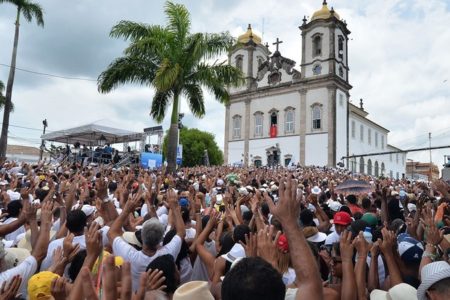
A Lavagem do Bomfim
During the traditional washing, the Church’s doors remain closed and the women from Bahia pour scented water onto the steps and churchyard, to the sound of Afro-religious touches and chants (although currently the ritual has an ecumenical profile), which occurs on the Thursday before the party and has a large participation of the people, who arrive in decorated carts, and the traditional Bahians, with their vases with scented water.
The festive washing takes place with the departure, on Thursday morning, of the traditional procession of Bahia women from the Church of Nossa Senhora da Conceição da Praia, which goes on foot to the top of Bonfim, to wash with brooms and scented water. stairs and the atrium of the Church of Nosso Senhor do Bonfim.
All are dressed in white, the color of the orixá, and travel 8 km in procession, from Largo da Conceição to Largo do Bonfim. The high point of the party occurs when the church steps are washed by around 200 Bahian women dressed in character who, from their ‘little rooms’ – vases, which they carry on their shoulders – pour water on the steps and in the church atrium, to the sound of applause. , atabaque drums and songs of African origin. Once the religious part is over, the party continues in the Largo do Bonfim, with drums, dances and drinks and typical food stalls.
On the Sunday following the washing, the devotees gather in the Church of the Seas for the procession of the Three Orders, which travels across the square of Rome towards Bonfim. Upon arrival at Bonfim Hill, the faithful take three turns around the Basilica, making three requests. A sermon, as well as a solemn Mass and the blessing of the Blessed Sacrament close the celebrations
Moving date: 2nd Thursday of January after Kings Day
Happens in: Salvador

Festa da Conceição da Praia
Traditional party in Largo, near the Mercado Modelo, with stalls serving typical foods and drinks, combining the profane joy of Bahian people with the sacred religious devotion. The three oldest historical references to the Conceição da Praia festival are at least 800 years old. The first of them took place in 1147, with the beginning of the devotion to the Saint, in Portugal. According to some accounts, the Portuguese became devotees of Nossa Senhora da Conceição as soon as they managed to retake Lisbon from the power of the Moors.
Another version marks the year 1549. According to historians, the tradition began in this country, as soon as the city of Salvador was founded by the governor-general of Brazil, Tomé de Sousa, a devotee of Santa.
A third theory goes back to the 1930s, when Monsignor Aquino Barbosa, vicar of Conceição da Praia, suggested to a Bahian woman from Acarajé to install a larger stall to sell food. From there, began the festive side that, until today, attracts thousands of people. The festivities begin at the end of November, with the novena that takes place every night at the Church of Nossa Senhora da Conceição da Praia, in Comércio.
The celebration involves an outdoor mass and procession. At the same time, there is the traditional Largo party, in the vicinity of the Mercado Modelo, with stalls offering typical food and drinks, combining the Bahian profane joy with sacred religious devotion.
When: December 8th
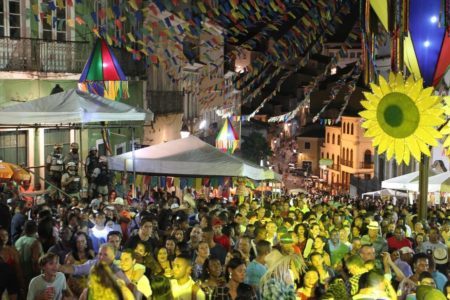
Festas de São João
State known for the joy of the people. The June festivals in Bahia are spread throughout the state, with attractions in all of its 417 municipalities, which attract thousands of tourists from all over Brazil. Feast of São João as festas juninas, dedicated to Santo Antônio, on June 13th, São João, on the 24th and São Pedro, on the 29th.


